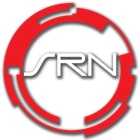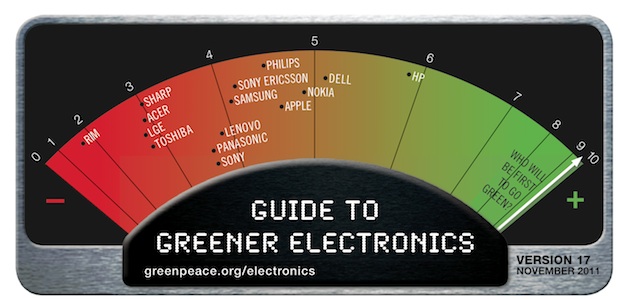One of the bright spots for Sony Corporation over the last few years has been their green initiative and their environmentally-healthy products and production plants. Sony regularly beat rivals like Apple, Samsung, and Nintendo in this area, who scored dead last among the top companies listed last year. Now, both Sony and Sony Ericsson have taken a dip in the most recent findings on the Greenpeace’s environmental rankings of electronics companies while rival Apple has now come ahead, ranking in 4th place and beating Sony for the first time.
Sony Ericsson, the soon-to-be-bought-out partnership between Sony and Ericsson is down four spots to number six, compared to last year. Sony Ericsson gets a joint top score on green products and good sustainable operation score but is weak on energy criteria. Sony by itself has also lost four spots in this year’s ranking, landing at the number ten spot while rival Apple is now up to number four. Samsung, one of Sony’s biggest rivals has also lost two spots, down to number seven. Sony receives a penalty point for lobby against stricter energy efficiency standards in California. However it also received top scores for supporting ambitious climate targets in Europe.
After the jump, the full report on Sony.
SONY Ranking = 4.6/10 – 1 = 3.6/10
Sony takes joint 9th position, together with Panasonic, with 3.6 points, reduced from 4.6 as a result of a penalty point, for comments it has made in opposition to energy efficiency standards in California. Sony also risks a penalty point in future Guide editions as it is a member of trade associations that have commented against stringent energy efficiency standards; it needs to distance itself from such regressive positions with a strong statement. On Products its performance on the energy efficiency of its products earns top marks; all of its TVs meet or exceed the latest Energy Star standards. It uses comparatively high quantities of post-consumer recycled plastics but no longer provides information on its use of recycled plastics as a percentage of total plastics used. It is less impressive on the other products criteria; it scores no points on product life cycle as it does not report on the length of warranty and spare parts availability for its main product lines. Although it has phased out polyvinyl chloride plastic (PVC) from many of its products the scope of its phase out of brominated flame retardants (BFRs) is limited.
Sony is a top scorer on Energy; together with Philips it has the highest score for energy policy advocacy, for calling upon the EU to adopt an unconditional 30 percent reduction target for greenhouse gas (GHG) emissions (below 1990 levels) by 2020, supporting climate protection and clean energy development across the EU. It also gets maximum points for its verified disclosure of GHG emissions for its own operations. It aims to reduce GHG emissions by an absolute value of 30 percent from the fiscal 2000 level and has achieved reductions in its emissions well above the original mid-term target, although it does not specify a target for renewable energy. Sony’s strategy for reducing GHG emissions includes energy efficiency and increasing use of renewable energy, which currently accounts for 9 percent of the total amount of electricity that Sony purchases globally each year. It needs to set an ambitious goal to increase its use of renewable energy by 2020.
It performs worst on Sustainable Operations; it scores no points on paper policy and it risks a penalty point in future editions of the Guide as it is listed as a client of Asia Pulp and Paper (APP), which is responsible for illegal logging and deforestation in Indonesia. Sony should immediately and public commit to stop sourcing any paper or packaging needs from APP. On conflict minerals it has started to identify certain minerals used in Sony products and in its supply chain and will identify measures to eliminate such conflict minerals as far as possible; it needs to map its smelters and suppliers. Sony bases its chemicals management on the precautionary principle; however its programme does not fully implement this. It still has not expanded its take-back programme in non-OECD countries sufficiently, and needs to report its recycling rate globally. It reports on the GHG emissions of its main suppliers, conducts product life cycle assessments and plans to expand the scope of both these initiatives in future.
SONY ERICSSON, 6th position, 4.2/10
Sony Ericsson takes 6th place in the re-launched Guide. It is one of the top scorers in the Products category, scoring maximum points for the energy efficiency of its phones, its advice to users and its targets to increase their efficiency. It is close to scoring maximum points for its avoidance of hazardous substances in its products, with only a few exemptions for uses of antimony and some types of phthalates remaining. It reports the recycled plastics content for several of its phones but still needs to report the amount of recycled plastic sourced as a percentage of all plastics used. To score on the product life cycle category it needs to publicly disclose the length of warranty and spare parts availability for its main product lines.
It scores less well on Energy, with most points for its targets to reduce greenhouse gas (GHG) emissions from its internal activities by 20 percent by 2015, however, it needstosetamoreambitioustargetofatleast30percentby2015andaimtouse100percentrenewableelectricityby2020. Although31percentoftheelectricity if purchases globally is from renewable sources, it does not set out a plan to reduce its GHG emissions through energy efficiency or more use of renewable energy. It also fails to get maximum points for the reporting of its GHG emissions as there is no external verification and it lacks any specific examples of positive lobbying for a clean energy policy.
It scores relatively well on Sustainable Operations, with maximum points for its chemicals management policy and programme; its work with suppliers to avoid the use of restricted substances is a good example. It still needs to report total GHG emissions from its supply chain and set out a plan for reducing emissions, although it does provides some information from its product life cycle assessments. It reports the quantities of e-waste it collects as a percentage but needs to provide a better summary of the extent of its take-back programme. Sony Ericsson has not yet published or publicly mapped smelters or suppliers of conflict minerals and needs to provide proof of verification of its suppliers. It also needs to develop a paper procurement policy which excludes suppliers that are involved in deforestation and illegal logging.
Discuss:
Do you find it important for a company to be environmentally friendly?
[Via GreenPeace]

